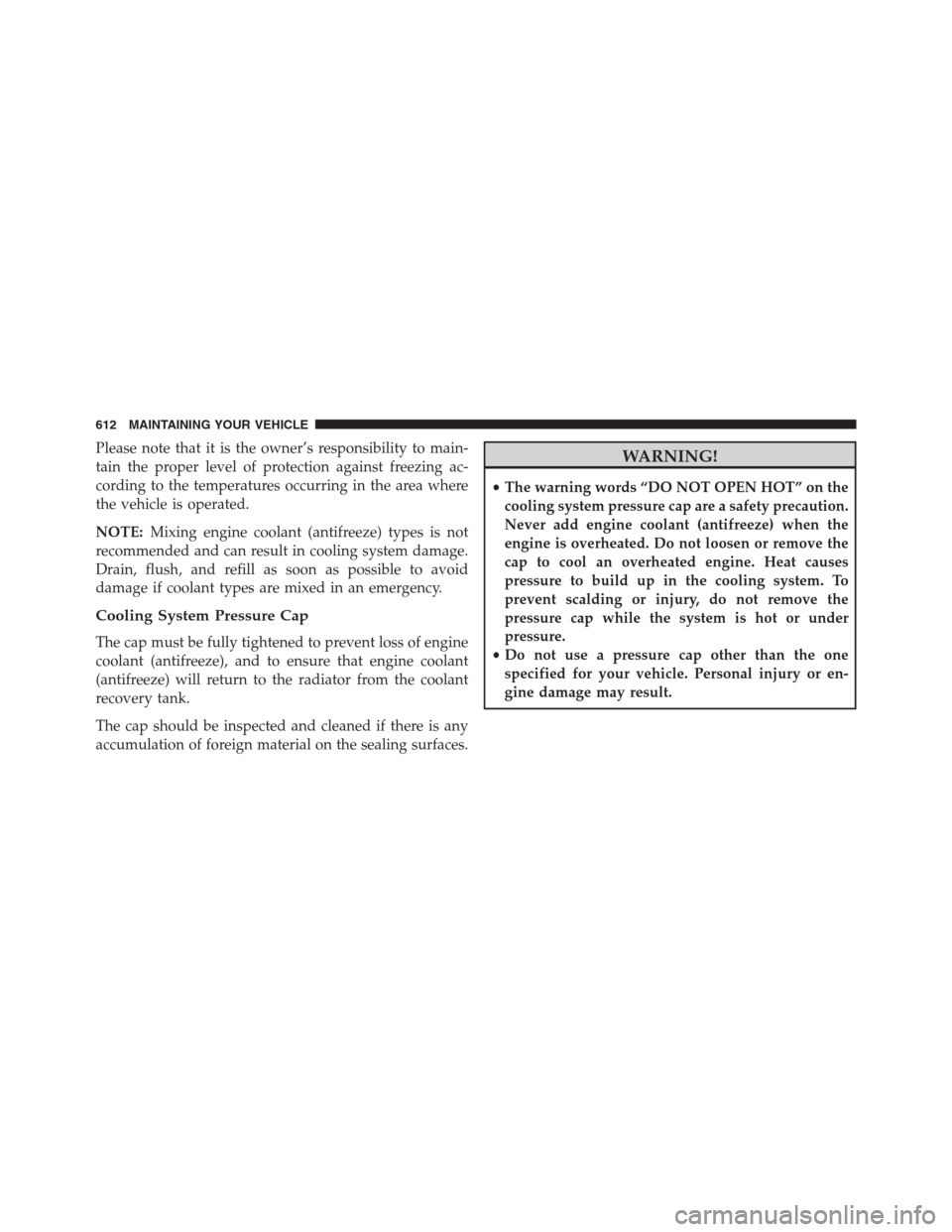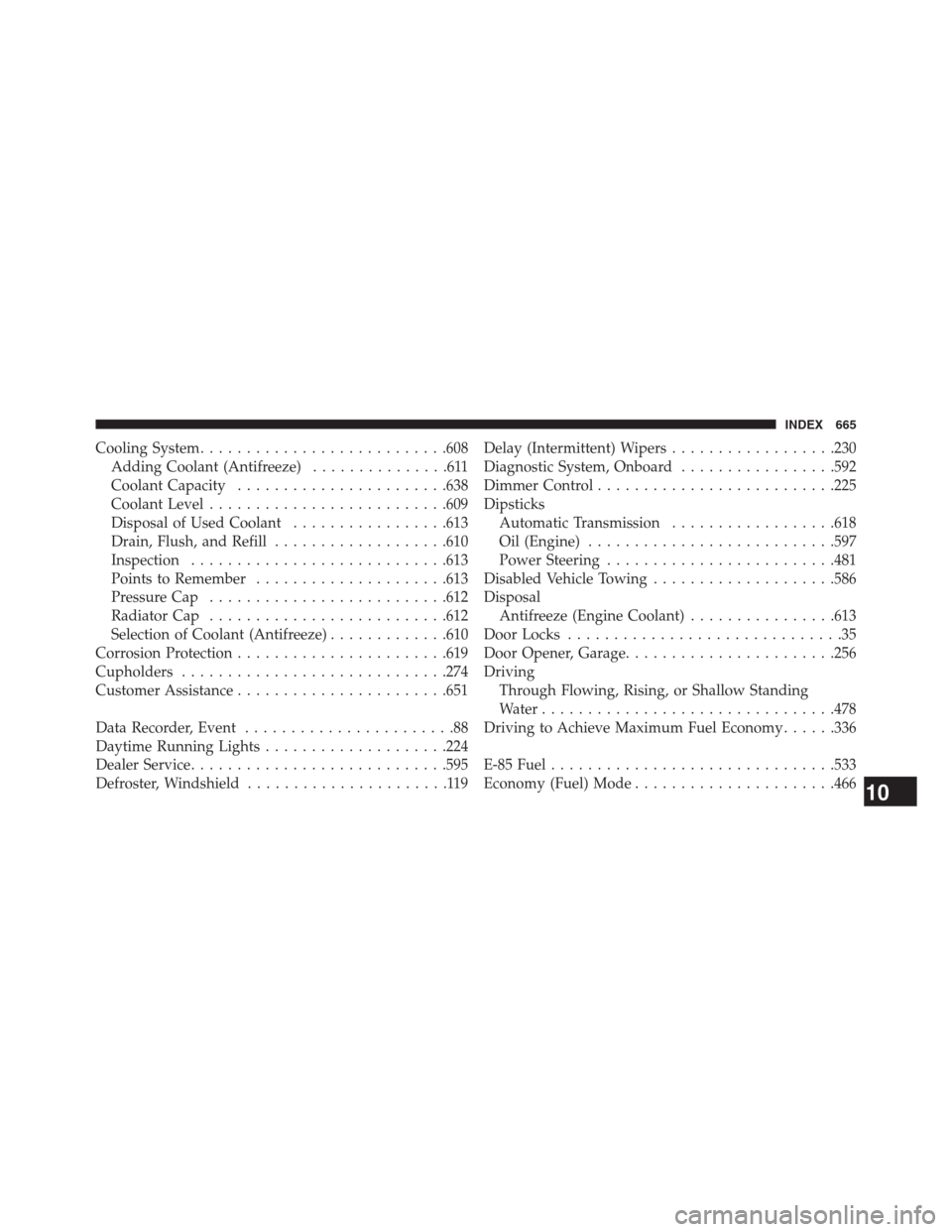2013 DODGE GRAND CARAVAN coolant level
[x] Cancel search: coolant levelPage 324 of 683

20. Temperature Gauge
The temperature gauge shows engine coolant tempera-
ture. Any reading within the normal range indicates that
the engine cooling system is operating satisfactorily.
The gauge pointer will likely indicate a higher tempera-
ture when driving in hot weather, up mountain grades,
or when towing a trailer. It should not be allowed to
exceed the upper limits of the normal operating range.
CAUTION!
Driving with a hot engine cooling system could damage
your vehicle. If the temperature gauge reads “H” pull
over and stop the vehicle. Idle the vehicle with the air
conditioner turned off until the pointer drops back into
the normal range. If the pointer remains on the “H” and
you hear continuous chimes, turn the engine off imme-
diately and call an authorized dealer for service.
WARNING!
A hot engine cooling system is dangerous. You or
others could be badly burned by steam or boiling
coolant. You may want to call an authorized dealer
for service if your vehicle overheats. If you decide to
look under the hood yourself, see “Maintaining Your
Vehicle”. Follow the warnings under the Cooling
System Pressure Cap paragraph.
21. Low Fuel Light
When the fuel level reaches approximately 2.0 gal
(7.8 L) this light will turn on, and remain on until
fuel is added.
322 UNDERSTANDING YOUR INSTRUMENT PANEL
Page 325 of 683

22. Charging System Light
This light shows the status of the electrical charg-
ing system. The light should come on when the
ignition switch is first turned to ON/RUN and remain on
briefly as a bulb check. If the light stays on or comes on
while driving, turn off some of the vehicle’s non-essential
electrical devices or increase engine speed (if at idle).
If the charging system light remains on, it means that the
vehicle is experiencing a problem with the charging
system. Obtain SERVICE IMMEDIATELY. See an autho-
rized dealer.
If jump starting is required, refer to “Jump Starting
Procedures” in “What To Do In Emergencies”.23. Oil Pressure Warning Light
This light indicates low engine oil pressure.
The light should turn on momentarily when the engine is
started. If the light turns on while driving, stop the
vehicle and shut off the engine as soon as possible.
A chime will sound when this light turns on.
Do not operate the vehicle until the cause is corrected.
This light does not indicate how much oil is in the engine.
The engine oil level must be checked under the hood.
24. Engine Temperature Warning Light
This light warns of an overheated engine condi-
tion. As engine coolant temperatures rise and the
gauge approachesH, this indicator will illuminate and a
single chime will sound after reaching a set threshold.
Further overheating will cause the temperature gauge to
passH, a continuous chime will occur until the engine is
allowed to cool.
4
UNDERSTANDING YOUR INSTRUMENT PANEL 323
Page 614 of 683

Please note that it is the owner’s responsibility to main-
tain the proper level of protection against freezing ac-
cording to the temperatures occurring in the area where
the vehicle is operated.
NOTE:Mixing engine coolant (antifreeze) types is not
recommended and can result in cooling system damage.
Drain, flush, and refill as soon as possible to avoid
damage if coolant types are mixed in an emergency.
Cooling System Pressure Cap
The cap must be fully tightened to prevent loss of engine
coolant (antifreeze), and to ensure that engine coolant
(antifreeze) will return to the radiator from the coolant
recovery tank.
The cap should be inspected and cleaned if there is any
accumulation of foreign material on the sealing surfaces.
WARNING!
•The warning words “DO NOT OPEN HOT” on the
cooling system pressure cap are a safety precaution.
Never add engine coolant (antifreeze) when the
engine is overheated. Do not loosen or remove the
cap to cool an overheated engine. Heat causes
pressure to build up in the cooling system. To
prevent scalding or injury, do not remove the
pressure cap while the system is hot or under
pressure.
•Do not use a pressure cap other than the one
specified for your vehicle. Personal injury or en-
gine damage may result.
612 MAINTAINING YOUR VEHICLE
Page 615 of 683

Disposal Of Used Engine Coolant
Used ethylene glycol-based engine coolant (antifreeze) is
a regulated substance requiring proper disposal. Check
with your local authorities to determine the disposal
rules for your community. To prevent ingestion by ani-
mals or children, do not store ethylene glycol-based
engine coolant in open containers or allow it to remain in
puddles on the ground. If ingested by a child or pet, seek
emergency assistance immediately. Clean up any ground
spills immediately.
Coolant Level
The coolant bottle provides a quick visual method for
determining that the coolant level is adequate. With the
engine OFF and cold, the level of the engine coolant
(antifreeze) in the bottle should be between the ranges
indicated on the bottle.The radiator normally remains completely full, so there is
no need to remove the radiator cap unless checking for
engine coolant (antifreeze) freeze point or replacing cool-
ant. Advise your service attendant of this. As long as the
engine operating temperature is satisfactory, the coolant
bottle need only be checked once a month.
When additional engine coolant (antifreeze) is needed to
maintain the proper level, only OAT coolant that meets the
requirements of Chrysler Material Standard MS-12106
should be added to the coolant bottle. Do not overfill.
Points To Remember
NOTE:When the vehicle is stopped after a few miles/
kilometers of operation, you may observe vapor coming
from the front of the engine compartment. This is nor-
mally a result of moisture from rain, snow, or high
humidity accumulating on the radiator and being vapor-
ized when the thermostat opens, allowing hot engine
coolant (antifreeze) to enter the radiator.7
MAINTAINING YOUR VEHICLE 613
Page 640 of 683

3. Push the bulb into the socket, twist the socket into the
lamp assembly and reinstall the lamp assembly into
place ensuring the locking tab is secure.
FLUID CAPACITIES
U.S. Metric
Fuel (Approximate)20 Gallons 76 Liters
Engine Oil with Filter
3.6L Engine (SAE 5W-20, API Certified) 6 Quarts 5.6 Liters
Cooling System *
3.6L Engine (MOPAR® Antifreeze/Engine Coolant
10 Year/150,000 Mile Formula or equivalent)13.4 Quarts 12.6 Liters
* Includes heater and coolant recovery bottle filled to MAX level. Add 2.9 Qts (2.8 L) if equipped with a rear
heater.
638 MAINTAINING YOUR VEHICLE
Page 644 of 683

MAINTENANCE SCHEDULE
Your vehicle is equipped with an automatic oil change
indicator system. The oil change indicator system will
remind you that it is time to take your vehicle in for
scheduled maintenance.
Based on engine operation conditions, the oil change
indicator message will illuminate. This means that ser-
vice is required for your vehicle. Operating conditions
such as frequent short-trips, trailer tow, extremely hot or
cold ambient temperatures, and E85 fuel usage will
influence when the “Oil Change Required” message is
displayed. Severe Operating Conditions can cause the
change oil message to illuminate as early as 3,500 miles
(5,600 km) since last reset. Have your vehicle serviced as
soon as possible, within the next 500 miles (805 km).
Your authorized dealer will reset the oil change indicator
message after completing the scheduled oil change. If a
scheduled oil change is performed by someone other thanyour authorized dealer, the message can be reset by refer-
ring to the steps described under “Electronic Vehicle Infor-
mation Center (EVIC)/Oil Change Required” in “Under-
standing Your Instrument Panel” for further information.
NOTE:Under no circumstances should oil change inter-
vals exceed 10,000 miles (16,000 km) or twelve months,
whichever comes first.
Once A Month Or Before A Long Trip:
•Check engine oil level
•Check windshield washer fluid level
•Check the tire inflation pressures and look for unusual
wear or damage
•
Check the fluid levels of the coolant reservoir, brake
master cylinder, power steering and transmission as
needed
•Check function of all interior and exterior lights
8
M
A
I
N
T
E
N
A
N
C
E
S
C
H
E
D
U
L
E
S642 MAINTENANCE SCHEDULES
Page 665 of 683

Automatic Transmission....................464
Adding Fluid..........................618
Fluid and Filter Changes..................618
Fluid Change..........................618
Fluid Level Check.......................618
Fluid Type............................617
Gear Ranges...........................469
Special Additives.......................617
Torque Converter.......................476
Auto Up Power Windows....................42
Battery.................................603
Jump Starting..........................579
Keyless Transmitter Replacement (RKE)........28
Saving Feature (Protection)................228
Belts, Seat...............................118
Blind Spot Monitoring......................136
Body Mechanism Lubrication.................607
B-Pillar Location..........................502Brake Assist System.......................487
Brake Control System, Electronic..............486
Brake Fluid.............................640
Brake System............................615
Fluid Check...........................615
Parking..............................481
Warning Light.........................320
Brake/Transmission Interlock.................466
Bulb Replacement.........................635
Bulbs, Light.............................120
Calibration, Compass......................340
Camera, Rear............................249
Capacities, Fluid..........................638
Caps, Filler
Fuel.................................537
Power Steering.........................481
Radiator (Coolant Pressure)................612
Carbon Monoxide Warning
..................11710
INDEX 663
Page 667 of 683

Cooling System...........................608
Adding Coolant (Antifreeze)...............611
Coolant Capacity.......................638
Coolant Level..........................609
Disposal of Used Coolant.................613
Drain, Flush, and Refill...................610
Inspection............................613
Points to Remember.....................613
Pressure Cap..........................612
Radiator Cap..........................612
Selection of Coolant (Antifreeze).............610
Corrosion Protection.......................619
Cupholders.............................274
Customer Assistance.......................651
Data Recorder, Event.......................88
Daytime Running Lights....................224
Dealer Service............................595
Defroster, Windshield......................119Delay (Intermittent) Wipers..................230
Diagnostic System, Onboard.................592
Dimmer Control..........................225
Dipsticks
Automatic Transmission..................618
Oil (Engine)...........................597
Power Steering.........................481
Disabled Vehicle Towing....................586
Disposal
Antifreeze (Engine Coolant)................613
Door Locks..............................35
Door Opener, Garage.......................256
Driving
Through Flowing, Rising, or Shallow Standing
Water................................478
Driving to Achieve Maximum Fuel Economy......336
E-85 Fuel...............................533
Economy (Fuel) Mode......................466
10
INDEX 665